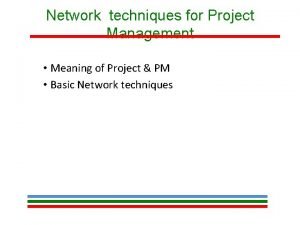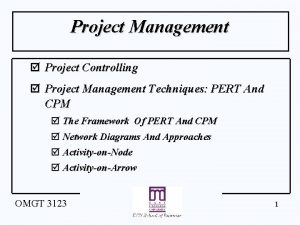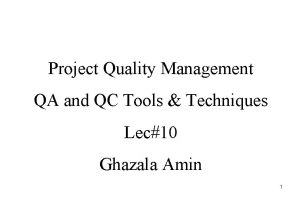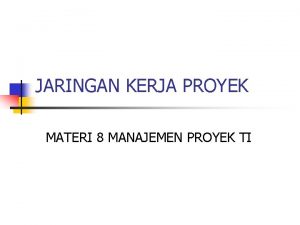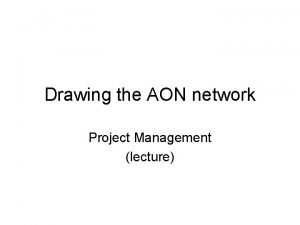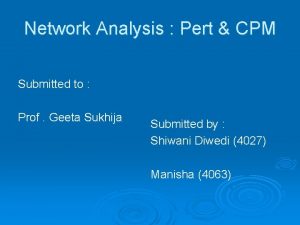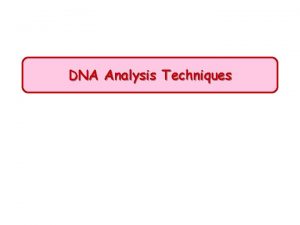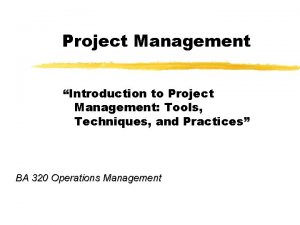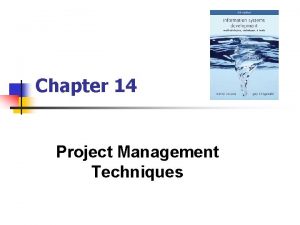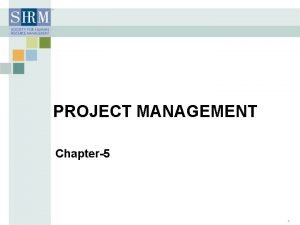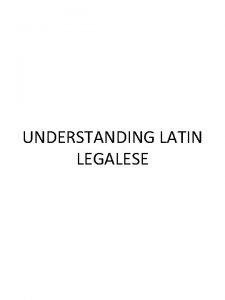Network techniques for Project Management Meaning of Project































- Slides: 31

Network techniques for Project Management • Meaning of Project & PM • Basic Network techniques

Introduction to Project Management • A temporary endeavour undertaken to create a unique product or service (PMI, 2004, P. 5) • Variety and unique in nature • Mainly used for large R& D activities • Project management mainly developed by military

Two basic Network techniques • PERT an acronym for Program Evaluation Review Technique • Originally developed to facilitate the planning and scheduling the Polaris Fleet Ballistic Missile project of US • PERT is Probabilistic • CPM an acronym for Critical Path Method • developed in 1957 by the Du. Pont company in US to solve scheduling problems in industrial setting. • CPM is concerned with the trade off between cost and time.

Definitions used in PERT CPM • Activity: A time consuming task. An effort that require resources and take a certain time for completion i. e. designing a part, connecting a bridge girder • Event: A milestone. Is a specific point in time indicating beginning or ending of one or more activities. Does not consume time or resources.

Rules for Network Construction • Each activity must have a preceding and a succeeding event • Each event should have a distinct number • There should be no loops in project network • Each activity is represented arrow. by a uniquely numbered

Example of PERT Activity Optimist Most ic likely Pessimis Te=ta+4 Variance tic tm+tb/6 V=(ba)/6 1 -2 9 12 21 13 2 1 -3 6 12 18 12 2 2 -4 1 1. 5 5 2 1 3 -4 4 8. 5 10 8 1 2 -5 10 14 24 15 2. 33 4 -5 i. iii. iv. v. 1 2 3 2 0. 33 Draw the network diagram Determine critical path Calculate event slack and activity float Find the standard deviation of CP duration Compute the probability of completing the project in 25 weeks

PERT Analysis Uses 3 time estimates for each activity Optimistic time (a) Pessimistic time (b) Most likely time (m) These estimates are used to calculate an expected value and variance for each activity (based on the Beta distribution)

PERT Analysis Expected activity time (t) t = (a + 4 m + b) 6 Variance = [ (b – a) / 6 ]2 Standard deviation = SQRT(variance) = (b – a) 6

Project Variance and STD Deviation 2 • Project variance (σp ) = ∑ (variances of all critical path activities) σp 2 = 0. 11 + 1. 0 + 1. 78 + 0. 11 = 3. 11 • Project standard deviation (σp) = SQRT (Project variance) σp = SQRT ( 3. 11) = 1. 76

PERT Analysis Z = (Target time – expected time) σp Z = (16 - 15) = 0. 57 1. 76 This means 16 weeks is 0. 57 standard deviations above the mean of 15 weeks.

7 2 10 10 1 6 5 7 3 2 5 4 4 5 5 7 8

CPM • Cost -Time Relationship • Expediting projects • Expediting activities requires additional resources, which means increasing the cost of the project. • Slope gives us the cost increase associated with a reduction of one unit of the activity duration • Slope =Cc-Cn/Tn-Tc

Example 1 Activity i. iii. iv. Activity Normal Crash week Cost Slope Week Cost Cc-Nc/Tn. Tc A 0 -1 5 100 4 140 40 B 0 -2 9 200 7 300 50 C 1 -2 7 250 4 340 30 D 1 -3 9 280 7 340 30 E 2 -4 5 250 2 460 70 F 2 -5 11 400 7 720 80 G 3 -5 6 300 4 420 60 I 4 -5 8 80 6 140 30 Find the all normal schedule and cost Find the all-crash schedule and cost Find the least cost plan for all crash time schedule Find the least cost plan for an intermediate time schedule of 22 weeks.

CPM Contd. . all normal solution 1 D 9 3 A 5 C 7 E 5 0 G 6 H 0 B 9 2 4 I 8 F 11 • 0 -1 -2 -4 -5 is the critical path • Duration=5+7+5+8=25 weeks. • Cost=1860 5

CPM Contd. . All crash solution D 7 3 1 G 4 H 0 A 4 C 4 E 2 0 B 7 2 4 F 7 • 0 -1 -3 -4 -5 is the critical path • Duration is 17 days • Cost=2860 I 6 5

Find the minimum cost for the Crash time D 7 3 1 G 4 H 0 A 4 C 4 E 2 0 B 7 2 4 F 7 • 0 -1 -3 -4 -5 is the critical path • Duration is 17 days • Cost=2860 I 6 5

Find the minimum cost for the Crash time D 7 3 1 G 4 H 0 C 4 A 4 E 2 0 B 7 2 4 F 7 I 6 5 • Step 1 - Get the non critical activities with their slope • Step-2 Select the activity which has largest slope & expand as much as possible to achieve as a large a cost reduction is possible • Step-3 Expand the next largest activity slope and continue until all path become critical.

Find the minimum cost for the Crash time D 7 1 3 G 4 H 0 A 4 C 4 E 2 • • 4 I 6 5 F 7 B 7 2 0 Step 1 - Get the non critical activities with their slope =B-50 C-30, E-70, G-60, F-80 Step-2 Select the activity which has largest slope & expand as much as possible to achieve as a large a cost reduction is possible= Select F for 2 days expansion cost 160 Step-3 Expand the next largest activity slope and continue until all path become critical. =E one day is possible at$70 in similar manner G by 2 days cost 120 finally activity B can be expanded by one day “ $50 saving. So total cost savings are : 160+70+120+50=400. Thus the revised cost for 17 days are 2860 -400=$2460

Determine the least cost plan for any desired number of days ie Least cost plan for 22 days • First step is to list all critical activities and their slope Critical activities Activities by events Slope A 0 -1 40 C 1 -2 30 E 2 -4 70 I 4 -5 30 • The activity with the least slope will be compressed first, because decreasing the project time by one day will result in smallest increase in cost. in this case activity C & I can be selected, arbitrarily C is selected but how many days -the most is up to is crash time 4 days here. However such a reduction may create one or more additional critical path. The minute an additional CP is created, the compression should be stopped. Thus here C is reduced from 7 days to 4 days at a cost of 90. So the least cost plan for 22 days is 1860+90=1950

Example 2 • i. iii. iv. The following data were obtained from a study of the time required to overhaul a small power plant. Activity Crash Schedule Week cost 1 -2 3 6 1 -3 1 5 2 -4 5 7 3 -4 2 6 2 -6 2 5 Find the all normal schedule and cost 4 -6 5 Find the all-crash schedule and cost 4 -5 4 Find the least cost plan for all crash time schedule Find the least cost plan for an intermediate time schedule of 17 weeks. 6 -7 1 5 -7 1 9 6 4 5

Example 2 edule • Normal The following data were obtained from a study of the time 5 required 4 to overhaul a small power plant. i. iii. 5 3 10 4 7 4 6 3 11 6 6 3 5 2 4 2 6 6 5 2 11 10 1 5 3 5 7 4 6 4 7 5 Find the all normal schedule and cost 1 -2 -6 -7=16 , 1 -2 -4 -6 -7=31, 1 -2 -4 -5 -7=25, 1 -3 -4 -6 -7=28, 1 -3 -4 -7=22 and cost= 4+4+6+2=16 Find the least cost plan for all crash time schedule Find the least cost plan for an intermediate time schedule of 17 weeks.

Example 2 l 4 • The following data were obtained from a study of the time required to overhaul a small power plant. 6 2 3 3 4 4 2 6 5 5 1 3 3 1 2 4 4 1 7 5 2 2 i. iii. Find the all crash schedule and cost 1 -2 -6 -7=6 , 1 -2 -4 -6 -7=14, 1 -2 -4 -57=13, 1 -3 -4 -6 -7=9, 1 -3 -4 -5 -7=8 and cost= 6+7+9+4= 26 Find the least cost plan for all crash time schedule Find the least cost plan for an intermediate time schedule of 17 weeks.

Example 2 al The following Slope data were obtained from a study of the time required to ule Cc-nc/nt-ct overhaul a small power plant. 1 4 6 6 0. 5 3 5 2 5 0. 6 4 11 0. 4 4 10 1 4 0. 5 3 6 4 0. 5 5 6 3 5 1. 5 7 3 2 0. 5 2 1 i. ii. Find the least cost plan for all crash time schedule. Find the least cost plan for an intermediate time schedule of 17 weeks. 7

Project Management Framework

P

Project Management Framework

Project Management Framework

Project Management Framework

Project Management Framework

Project Management Framework

Project Management Framework
 Explain network techniques of project management.
Explain network techniques of project management. Network traffic management techniques
Network traffic management techniques Introduction for project
Introduction for project Risk response types
Risk response types Pert techniques in project management
Pert techniques in project management Project management facilitation techniques
Project management facilitation techniques Quality control tools and techniques in project management
Quality control tools and techniques in project management Fonctions et solutions techniques
Fonctions et solutions techniques Jaringan kerja proyek
Jaringan kerja proyek Draw the aon network for the construction activity
Draw the aon network for the construction activity Aon in project management
Aon in project management Network analysis cpm
Network analysis cpm Formuö
Formuö Typiska novell drag
Typiska novell drag Tack för att ni lyssnade bild
Tack för att ni lyssnade bild Ekologiskt fotavtryck
Ekologiskt fotavtryck Shingelfrisyren
Shingelfrisyren En lathund för arbete med kontinuitetshantering
En lathund för arbete med kontinuitetshantering Personalliggare bygg undantag
Personalliggare bygg undantag Personlig tidbok för yrkesförare
Personlig tidbok för yrkesförare A gastrica
A gastrica Densitet vatten
Densitet vatten Datorkunskap för nybörjare
Datorkunskap för nybörjare Stig kerman
Stig kerman Mall för debattartikel
Mall för debattartikel Magnetsjukhus
Magnetsjukhus Nyckelkompetenser för livslångt lärande
Nyckelkompetenser för livslångt lärande Påbyggnader för flakfordon
Påbyggnader för flakfordon Tryck formel
Tryck formel Svenskt ramverk för digital samverkan
Svenskt ramverk för digital samverkan Jag har gått inunder stjärnor text
Jag har gått inunder stjärnor text Presentera för publik crossboss
Presentera för publik crossboss
